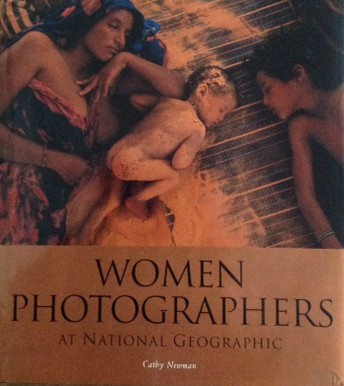Inspiring Older Readers
 posted on 24 Dec 2017
posted on 24 Dec 2017
Women Photographers at National Geographic by Cathy Newman
Here’s a conundrum for you. When photography books are so expensive, often more expensive on the second hand market than when new, why is it that this large format rather nicely produced collection is ridiculously cheap? I really have no idea unless there’s something about the National Geographic that’s not highly thought of or maybe it’s just that there were lots of them published. Who knows? Whatever the answer, this is a really fascinating book.
The short preface written by Tipper Gore in 2000 makes the point that this is the first time a collection has been put together by the National Geographic that exclusively showcases the work of women photographers that they have commissioned. Making your living as documentary magazine photographer is tough enough for anyone but in the very male dominated world of photo-journalism it is even harder for women who face so many structural and discriminatory barriers.
The book is built around a handful of specific portfolios from Karen Kasmauski, Sisse Brimberg, Maria Stenzel, Annie Griffiths Belt and, my personal favourite, Jodi Cobb. That’s not to say that these are the only photographers featured – far from it. Their work surrounds examples of photographs from the likes of luminaries such as Margaret Bourke White and Mary Ellen Mark and colour prints sit alongside black and white and even pioneering sepia.
To be perfectly honest, the text by Cathy Newman is nothing special and maybe there’s a little too much of it but as you might expect the focus of the essays is more about how these photographers have shaped the output of National Geographic and vice versa. There’s just a hint of puff journalism here and a suspicion that the book was conceived of as a promotional tool but it’s not too hard to understand why that may be.
The photographs contained in this collection cover an astonishing range of subjects – you’ll find issues as diverse as poverty and war, travel and fashion and personal identity. There are also some extraordinary photographs dealing with the environment and environmental degradation. The stories of how the photographs were captured are probably the most engaging part of the book – Annie Griffiths Belt, for example, passed herself off as a man in order to get access to an Isreali ceremony closed to women. Dorothy Hosmer’s photographs of a bicycle tour she made in Romania in 1937 were suppressed for many years by the magazine’s editor at that time because he considered the way the photographs were obtained to not be ‘ladylike’.
The danger with collections like these is that the editorial decisions and the themes that are meant to knit the book together aren’t really robust enough to prevent the selection from looking at bit haphazard or muddled and this is a criticism that could be levelled at this book.
But that’s really a minor criticism and the fact that you can get this book for small change should really encourage you to get your hands on a copy because even if you only find a handful of pictures you like, it would still be value for money.
Terry Potter
December 2017